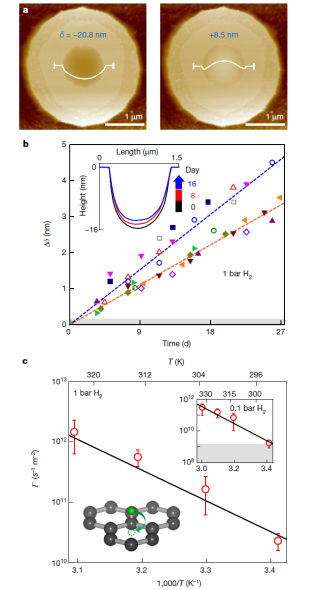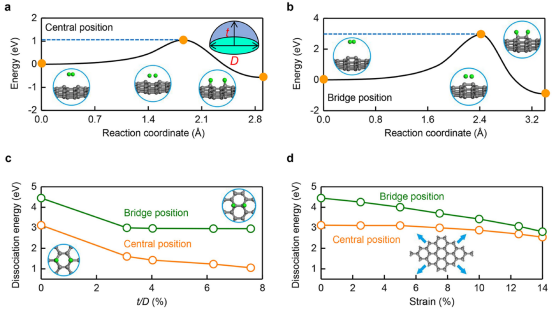On March 11, Nature published online the latest joint research findings on the limits on gas impermeability of graphene by Professor Yuan Shengjun from the School of Physics and Technology and other research teams at home and abroad.
The paper, Limits on gas impermeability of graphene, was co-authored by Prof. Yuan and Prof. Sir Andre Geim, a Nobel laureate from the University of Manchester.
Two-dimensional materials, represented by monolayers graphene, are considered to have no permeability to gases and liquids, even though they are merely of one atom thick. Theoretical calculation shows that the defect-free monolayer graphene has a very high energy barrier to the permeability of gas molecules, and no gas can be penetrated under normal conditions. It is also theoretically indicated that the penetration of a molecule through a defect-free graphene at room temperature takes longer than the lasting of the universe history. So is defect-free graphene really impervious to gases? What is the limit?The experimental team led by Andre Geim and the theoretical team led by Yuan Shengjun collaborated to confirm the impenetrability of defect-free graphene through experiments and theoretical calculations, which extended the limit of impenetrability. It also revealed the abnormal permeability mechanism of hydrogen in graphene. Using a small single-crystal vessel sealed with a defect-free monolayer graphene as the experimental setup, it was discovered that graphene is indeed impermeable to most gases, and the detection accuracy gets improved by 8-9 orders of magnitude compared with previous experiments. Fluxes of only a few helium atoms per hour can be detected under such ultra-high detection conditions. This behavior is consistent with almost all other gases (neon, nitrogen, oxygen, argon, and xenon) except hydrogen.
Hydrogen molecule is theoretically larger than that of helium, and it will come across a higher barrier when directly penetrating, but hydrogen shows more obvious permeability. For this abnormal experimental phenomenon, Prof. Yuan’s team carried out theoretical calculations on a large number of graphene structures with different configurations, and found the main mechanism of this abnormal result: first, the undulation of graphene has catalytic activity, which can greatly reduce the activation energy of hydrogen molecule pyrolysis adsorption. This spontaneous fluctuation increases with the rise of temperature, and the activation energy of hydrogen molecule cracking can be as low as one electron volt. The second is that the adsorbed hydrogen atoms flip to the other side of the graphene film at a lower energy, which is close to the energy required for proton transfer.

Figure 1. Hydrogen permeability experiment

Figure 2. Hydrogen permeability calculation
This study provides important experimental data and theoretical explanations for the gas permeability limit of two-dimensional materials, and points out a new direction for the research of graphene. Such basic researches often open up a whole new field.
Co-authors of the work include Xiong Wenqi, a PhD student in Yuan's team at the School of Physics and Technology at Wuhan University, and Yu Jin, a postdoctoral fellow at Nijmegen University in the Netherlands. The work is supported by the National Key Research and Development Project (2018YFA0305800) and the Supercomputing Center of Wuhan University.

Prof. Yuan Shengjun's research team
Links to papers: https://www.nature.com/articles/s41586-020-2070-x
Doi:10.1038/s41586-020-2070-x
Attachment: Introduction to Yuan Shengjun

Yuan Shengjun, male, was born in April 1979, and is now a professor and doctoral supervisor in School of Physics and Technology of Wuhan university. Yuan got his bachelor's degree from the Department of Physics of Zhejiang University and his doctor's degree from the University of Groningen in the Netherlands. In December 2016, Yuan began to teach in the School of Physics and Technology of Wuhan University. He focuses on computational physics, condensed matter theory and high performance scientific computing, including the development of multi-scale simulation method for complex quantum system, the development of computational methods for quantum multibody problems, electrical, optical, transport, and isotopic properties of low-dimensional quantum systems, general quantum computer simulations, and relaxation and decoherence of strongly correlated spin systems.
Rewritten by: Wu Buer
Edited by: Cao Siyi, Shen Yuxi and Hu Sijia